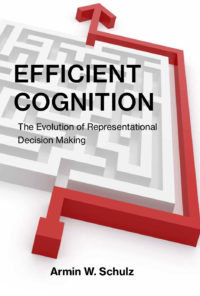Before it is possible to begin the investigation of the evolution of representational decision making it is necessary to address three foundational issues:
(1) The nature of representational decision making—what is it that we are investigating?
(2) The reality of representational decision making—why think that representational decision making is a real biological trait whose evolution can be investigated?
(3) The possibility of a plausible form of evolutionary psychology—how can we know anything about the evolutionary pressures on a cognitive trait?
Today, I sketch some answers to these three questions; my book spells out these sketches in (significantly!) more detail.

What is representational decision making? As noted last time, I take representational decision making to be decision making that depends on mental states downstream from the organism’s perceptual states. This way of understanding representational decision making follows several other accounts in the literature (such as those of Colin Allen and Jesse Prinz[1]) in using an architectural criterion to distinguish representational from non-representational decision making. A key benefit of this architectural criterion is that it allows us to sidestep questions about the nature of mental representation—this notion can just be taken for granted here.
With this in mind, note that three types of representational decision making can be distinguished. Cognitive representational decision making is based on mental representations about the state of the world: the organism processes its perceptions so as to form a mental state about the state the world is in, and then reacts to that cognitive state. Conative representational decision making is based on mental representations about what the organism is to do: the organism determines its behavioral response by consulting an explicitly encoded behavioral rule. Cognitive and conative representational decision making can come apart: an organism’s behavior can just be triggered by a representation of the state of the world, or its behavior can be determined by the consultation of a behavioral function that ranges over perceptual states only. Where organisms rely on both cognitive and conative representations—i.e. behavioral rules that range over representations of the state of the world—they are full representational decision makers.
Given this characterization of the nature of representational decision making, why think this is a biological trait that deserves to be taken seriously as the target of an evolutionary biological analysis? Note that this used to be—and still is—quite controversial; I return to some aspects of this dispute in a future posting. For now, though, three answers can be given. First, the reality of representational decision making is a basic assumption of much work in contemporary psychology—especially in cognitive psychology, but also in developmental and social psychology. Second, much the same goes for cognitive ethology—a field that has seen a revolution away from sophisticated forms of behaviorism towards representationalist cognitivism. Finally, work in cognitive neuroscience has identified several (mammalian) brain regions thought to be especially important for representational decision making: parts of the temporal and parietal lobes and the prefrontal cortex for cognitive representational decision making, and the basal ganglia, the cingulate, and parts of the prefrontal cortex for conative representational decision making. In short: the reality of representational decision making is a currently accepted part of the study of human and animal minds, and thus makes an appropriate subject for an evolutionary investigation.
Still, it needs to be acknowledged that laying out the evolutionary pressures even on well-confirmed cognitive traits is often thought to be highly unconvincing. In particular, critics are concerned that evolutionary psychology reduces to nothing but epistemically worthless storytelling.
As a blanket condemnation of evolutionary psychology, though, this view is unconvincing. On the one hand, providing an evolutionary account that coheres with the known features of the cognitive trait in question is not, in fact, trivial, and can yield surprising conclusions far from pure speculation. On the other hand, proving various evolutionary or non-evolutionary hypotheses about the trait in question should not be seen to be goal of this kind of project anyway. Rather, the goal should just to be to provide evidence—considerations that favor one hypothesis over another. This moderate form of evolutionary psychology is well illustrated by the study of the evolution of representational decision making.
—
[1] See e.g. C. Allen and M. Hauser, “Concept Attribution in Nonhuman Animals: Theoretical and Methodological Problems in Ascribing Complex Mental Processes,” Philosophy of Science 58 (1991); Jesse Prinz, Furnishing the Mind: Concepts and Their Perceptual Basis (Cambridge, MA: MIT Press, 2002).


With reference to potential objections to evolutionary psychology: perhaps these could be avoided by looking at the evolutionary of the brain architectures that enable representational decision making, rather than taking a psychological or behavioural view, which is at one remove from the underlying mechanisms? I think architecturally there is likely to be an evolutionary step change from direct sensor processing to representational decision making.
I agree that looking at the neural mechanisms underlying representational decision making is useful. I don’t think it needs to be done INSTEAD of approaching this issue from a psychological point of view, though; I think these are quite intertwined. I also don’t think that a focus on neural architecture, by itself, addresses some of the major concerns surrounding evolutionary psychology (viz., that it’s overly speculative). That said, I do think that looking at neural-architectural issues is very useful here; I will briefly return to this tomorrow.